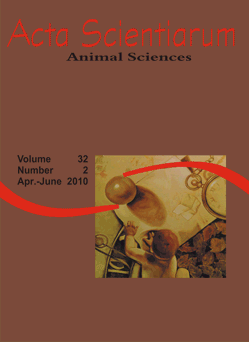<b>Dry mass and chemical composition of four <em>Brachiaria</em> species sown in rows or spread, in intercrop with corn crop in no-tillage system</b> - doi: 10.4025/actascianimsci.v32i2.8498
Keywords:
Brachiaria brizantha, Brachiaria decumbens, Brachiaria ruziziensis, Mulato II grass, crop-livestock integration
Abstract
The objective of this research was to evaluate the dry mass yield and chemical composition of four Brachiaria species in different options for sowing, exclusively or in intercrop with corn crop, under a no-tillage system. The experiment was carried out during the growing seasons of 2006 at FEPE (FE/Unesp, Ilha Solteira Campus) located in Selvíria, Mato Grosso do Sul State, Brazil. The soil of the experimental area was classified as distroferric Red Latosol (Oxisol). The experimental design was in randomized blocks, in a factorial scheme (4 x 4), with five replications. The treatments consisted of four Brachiaria species (Brachiaria brizantha cv. Marandu, Brachiaria decumbens, Brachiaria ruziziensis and Mulato II grass) grown in rows and spread on total area, exclusively or intercropped simultaneously with corn crop sowing. The study evaluated the dry mass yield and total digestible nutrients, crude protein, ash, neutral detergent fiber, acid detergent fiber, hemicelluloses, cellulose and lignin content of forage. The spread on total area intercrop of forages with corn crop proved to be viable by presenting similar dry mass yield to exclusive sowing arrangements, conversely to what happened with intercrop in row of corn crop, which decreased such yield. Brachiaria ruziziensis showed superior chemical composition and the intercrops increased energy and crude protein contents, and decreased cell wall components.Downloads
Download data is not yet available.
Published
2010-07-02
How to Cite
Pariz, C. M., Andreotti, M., Azenha, M. V., Bergamaschine, A. F., Mello, L. M. M. de, & Lima, R. C. (2010). <b>Dry mass and chemical composition of four <em>Brachiaria</em> species sown in rows or spread, in intercrop with corn crop in no-tillage system</b> - doi: 10.4025/actascianimsci.v32i2.8498. Acta Scientiarum. Animal Sciences, 32(2), 147-154. https://doi.org/10.4025/actascianimsci.v32i2.8498
Issue
Section
Pasture and forage utilization
DECLARATION OF ORIGINALITY AND COPYRIGHTS
- I Declare that current article is original and has not been submitted for publication, in part or in whole, to any other national or international journal.
The copyrights belong exclusively to the authors. Published content is licensed under Creative Commons Attribution 4.0 (CC BY 4.0) guidelines, which allows sharing (copy and distribution of the material in any medium or format) and adaptation (remix, transform, and build upon the material) for any purpose, even commercially, under the terms of attribution.
Read this link for further information on how to use CC BY 4.0 properly.
0.9
2019CiteScore
29th percentile
Powered by 








































